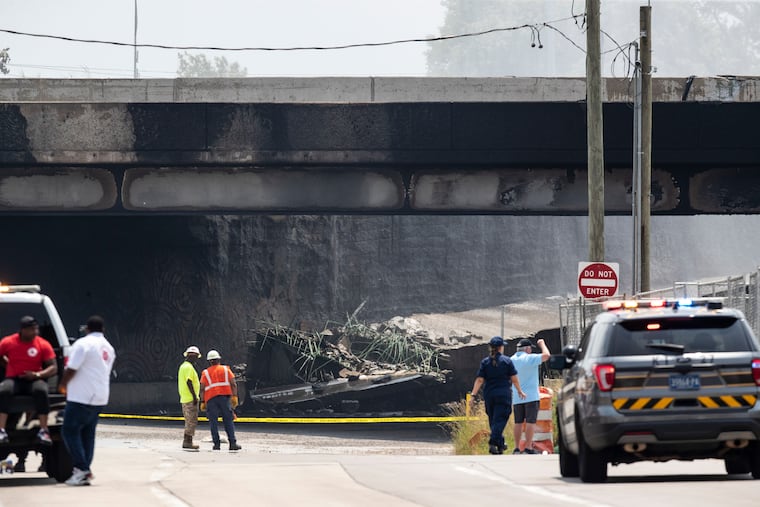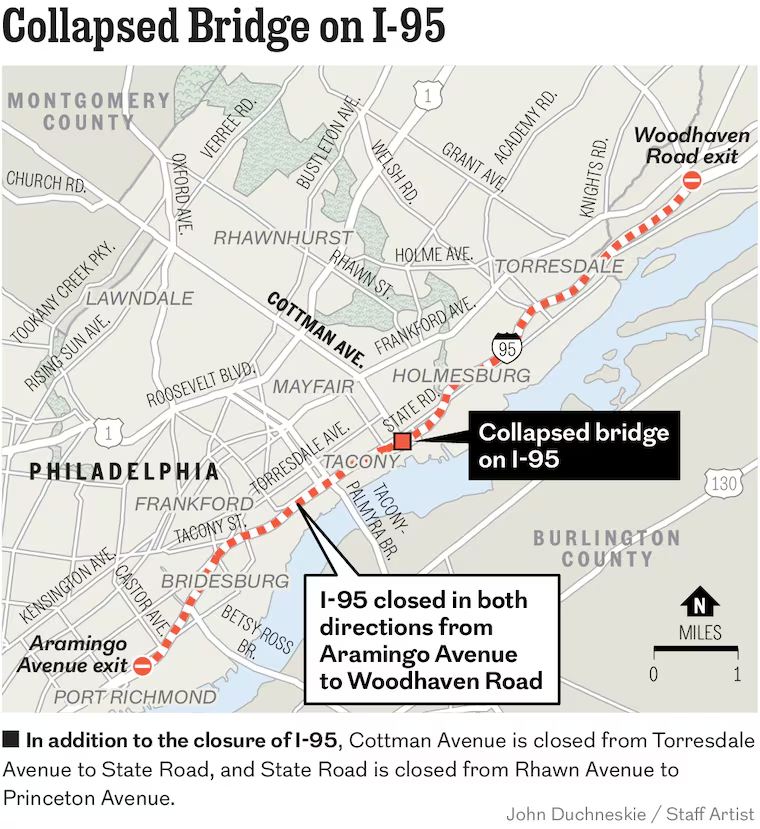I-95 bridge collapse: What we know and don’t know
What caused the fire, how commuters will cope, and other updates.

A collapsed bridge on the northbound lanes of Interstate 95 left the highway closed in both directions through much of Northeast Philadelphia on Sunday, likely disrupting the busy transportation corridor through the summer and beyond.
Officials released few details Sunday afternoon about the tanker-truck fire that led to the collapse, pending further investigation.
On Monday, some commuters reported that public transportation was busier as Northeast commuters took to trains. Local delivery trucks, meanwhile, faced frustrations due to increased traffic. State and local officials said they had devised a temporary plan with detours and additional SEPTA service.
The incident is expected to cause transit headaches for months.
Here’s what we know so far:
When and where did the fire and collapse happen?
A tanker truck caught fire at around 6:30 a.m. on the Cottman Avenue exit ramp from I-95 north, causing a bridge on the northbound highway to collapse. The Philadelphia Fire Department placed the blaze under control at 7:30 a.m.

What caused the fire?
It’s unclear.
Early Sunday, U.S. Coast Guard officials said the 8,500-gallon tanker carried gasoline. At an early-evening news conference Sunday, Gov. Josh Shapiro said only that it contained “a petroleum product.”
State Secretary of Transportation Mike Carroll said Monday that the tractor trailer driver was attempting to navigate a curve and lost control of the vehicle. It tipped over and landed on its side, causing its tank to rupture, and the petroleum product to ignite.
Asked about the cause of the blaze, he said it remained under investigation.
Was the bridge in good condition?
Yes, according to inspection reports. But a perfectly sound bridge can be vulnerable to fire.
Fire caused 30 U.S. bridge failures from 1980 to 2012 — roughly one per year — compared to just 20 failures from earthquakes, according to an analysis by University of Buffalo engineers.
The I-95 bridge was supported with girders made of steel, which has a melting point above 2,500 degrees Fahrenheit.
But fire can damage steel at temperatures well below that point, said Amir Farnam, an associate professor of civil, architectural and environmental engineering at Drexel University.
The metal loses about 20% of its strength at 750 degrees, and about half of its strength at 1,000 degrees, he said. Those temperatures are easily achieved with a tanker fire like the one that occurred Sunday morning, he said.
Was anyone hurt?
Officials Monday declined to identify the truck driver or trucking company whose tanker crashed, causing the fire. But the family of a tanker truck driver named Nathan S. Moody said Pennsylvania State Police had contacted them in efforts to confirm the identity of a driver who may have been killed in Sunday’s blaze. Moody, of New Jersey, drove for the Pennsauken-based TK Transport, which declined to comment when reached by The Inquirer.
The highway was closed soon after the fire broke out, and Mayor Jim Kenney said no motorists on I-95 were injured.
Are there any public health risks?
Philadelphia firefighters brought the fire under control by 7:30 a.m., an hour after responding to the scene.
While the fire was burning, fumes likely were hazardous to those nearby. At the news conference, Kenney said the job of first responders at the scene was “dangerous.”
But once the blaze was under control, any risk from airborne pollutants would’ve dissipated quickly, said physician Marilyn V. Howarth, director of community engagement at the University of Pennsylvania’s Center of Excellence in Environmental Toxicology.
“I don’t think it poses any additional harm,” she said in an interview. “Any carcinogens and particulates would’ve been dispersed and diluted fairly quickly once the fire was out.”
What should commuters do?
Good question. Work from home, if you can.
In that section of Northeast Philadelphia, the interstate remains closed in both directions for the foreseeable future. While the bridge collapsed only on the northbound side, the southbound side is not structurally sound, Shapiro said.
To accommodate the roughly 160,000 vehicles that normally travel the roadway every day, transportation officials have suggested detours, with the latest updates available at pa.gov/i95updates.
SEPTA is adding additional cars on its Trenton, West Trenton, and Fox Chase Regional Rail Lines. Additionally, three lots operated by the Philadelphia Parking Authority are offering free parking until further notice. Those lots are:
Fern Rock Rail Station: 10th and Nedro Streets
Fox Chase Rail Station: 500 Rhawn St.
Torresdale Rail Station: 4900 Grant Ave.
» READ MORE: What commuters can do after the I-95 shutdown
How long will it take PennDot to fix it?
Months, though an exact timeline has not been outlined. Shapiro issued a disaster declaration on Monday, which will allow the state to access federal funding and “expedite the rebuilding of I-95,” he said in a statement. That declaration makes $7 million of state funds immediately available for reconstruction.
But the project is nevertheless expected to take months.